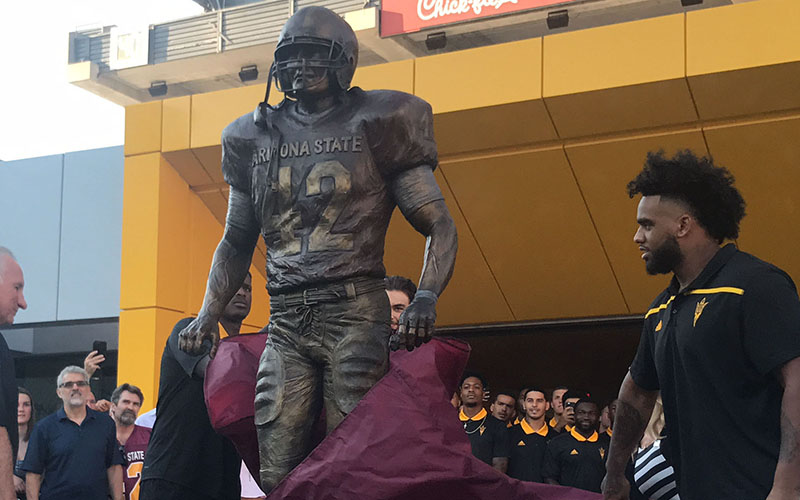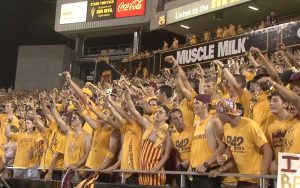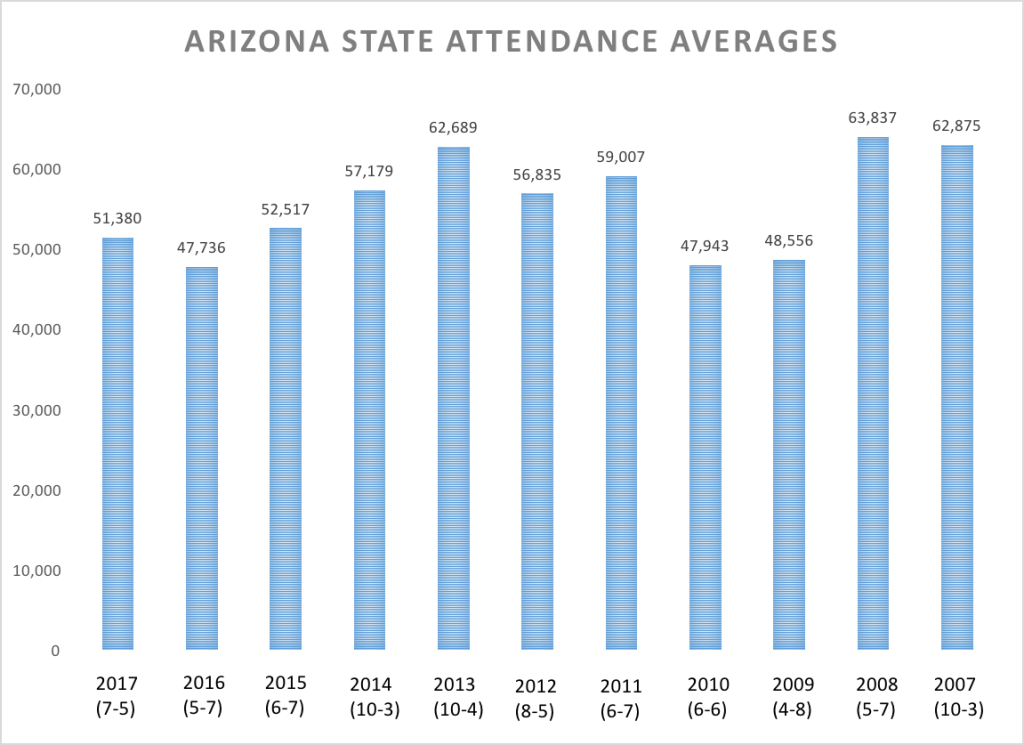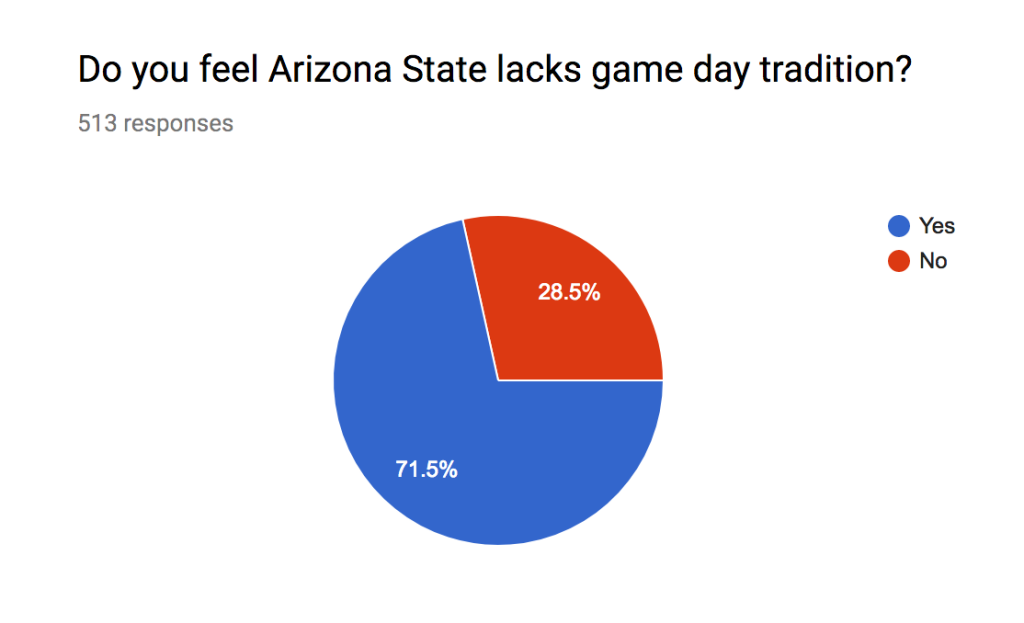
The Pat Tillman statue at Sun Devil Stadium is symbolic of the culture Arizona State hopes to build with its fan base. Many believe it would be advantageous to reconnect fans with the football program’s history. (Photo by Omar Soussi/Cronkite News)
PHOENIX — For many, sports serve as an escape from everyday life, a chance to engage with others who share a common interest. Throw in high-level competition and a large student enrollment and Arizona State seems like an ideal setting for a strong football fan base.
Yet the largest public university in the country should draw better, many believe. During the six-season Todd Graham era, for example, ASU finished fifth in attendance in the Pac-12 Conference four times and never higher than fourth. In the 2017 season, the Sun Devils averaged 51,380 fans, or 90 percent of the stadium’s 57,078 capacity.

Arizona State students cheer on the Sun Devils from one end of the new “Double Inferno” student seating at Sun Devil Stadium. (Cronkite News photo by Antonio Cannavaro)
Stadium capacity at Sun Devil Stadium has decreased steadily since 1991, when it peaked at 74,865. Although the removal of seats has helped increase the amount of seats filled, sellouts are rare.
Four issues are debated most: on-the-field product, local fan culture, the game day experience and game times.
“I would love any ideas on new traditions that we might consider,” said Ray Anderson, ASU’s vice president of athletics. “Particularly, my view is when those things are initiated by students or fans or alums, not necessarily the marketing or sponsorship department, sometimes they even get more traction.”
On-the-field product
Fans rarely want to spend time and money on a lackluster product. If the team isn’t performing well, a decrease in attendance is likely. Across the Pac-12, attendance numbers fluctuate based on a team’s win-loss record.
“The support for the teams comes in waves, I feel like, depending on if they’re good or not, which I hate to see because I’m a diehard fan,” said Chris Montano, a season-ticket holder since he began attending ASU in 2004. “Win, lose or draw, I always support them and go to the games.
“I hate it when the fan support kind of waivers and goes in and out, and I feel like ever since I’ve been a fan that’s always been the case.”
A correlation between success and fan interest is real. Attendance peaked during the Graham era in 2013, with an average of 62,869 going to games during the team’s 10-4 run and first-place finish in the Pac-12 South.
The lack of a strong performance and poor attendance often leads people to believe that a new coach is necessary and can restore a team’s dynasty, but that is not always the case. Since the Frank Kush era ended in 1979, only one coach — Bruce Snyder — stayed longer than six seasons.

Anderson felt the solution to this problem was to part ways with Graham after he posted an 18-19 record the past three seasons. Although he acknowledged the positives Graham had contributed to the program, Anderson didn’t feel he was the man to take the program to the next level.
“ASU and ASU football are in a much better place today than it was six years ago when Todd Graham took over … ” he said. “Coach Graham has done a marvelous job and we will applaud and thank him forever for having led in that effort. My job is to do what I can do to elevate us and make us better and that is why a change was made.”
By hiring Herm Edwards to oversee a football program that will be structured more like an NFL team, Anderson believes he has found his man.
“The No. 1 thing you try to do is put out very competitive, high-profile teams that will be entertaining and comprised of really high-quality student athletes,” Anderson said.

Arizona’s fan culture
It’s no secret that sports teams across the state face similar issues. Poor attendance, especially when a team is struggling, is common. Beautiful weather for much of the year and other entertainment options keep people away from sporting events.
A variety of factors contribute to fan support challenges. A transient population, the number of other local sports teams and, some believe, the lack of community engagement by the university all have an impact.

Many of Arizona’s residents grew up somewhere else and relocated to the Valley. Maricopa County had the highest population growth in the United States in 2016, the most recent U.S. Census reported. Many spent their childhood rooting for a different school, or attended college somewhere else. Although population growth in the Valley is rapid, it does not necessarily mean new residents will be Arizona State fans.
Additionally, many longtime season-ticket holders have followed the team since the Frank Kush era (1958-79), when ASU was a powerhouse. During Kush’s time at the helm, the Sun Devils only had one other professional sports team to compete with in the state: the Suns, who came to Phoenix as an expansion team in 1968.
“Pretty much all there was for sports in the Valley was ASU football and Phoenix Suns basketball,” said, Pat Gammill, a longtime Sun Devils fan and season-ticket holder since 1971.
“There was a lot of publicity from the local media about ASU football back in those days. That’s the reason why Sun Devil Stadium grew from a 51,000-seat stadium back when I first started going to see games to a 73,000-seat stadium, because literally the stadium was packed every weekend. It was an event to go to an ASU football game.”
In 1988, a culture shift began when the Cardinals moved to Arizona. Football fans now had the option to watch professional football. Then, in 1996, the Coyotes relocated from Winnipeg to Arizona, and in 1998, the Arizona Diamondbacks expansion team took root.
Arizona is one of only 13 markets with four major sports teams and the addition of those three provided more options for sports fans and their entertainment dollars.
“Once the Cardinals moved here, I think a lot of people had to make a decision on whether they wanted to be a season-ticket holder for the NFL or a season-ticket holder for ASU because I think most people couldn’t afford to be both,” Gammill said.
The solution?
Since Arizonans have so many options, many believe the university would benefit from doing more community engagement events, such as athletes visiting with young athletes in their respective sports, or hosting events that promote schools or age groups to come out.
“I know they have junior Sun Devil Club and things like that. They have some things, it seems, but I think that they could probably manage to do more,” said Joe Healey, a longtime fan who attended his first game in 1996 for his 14th birthday and hosts “Speak of the Devils” podcast.
Recently, Graham invited the Moon Valley High School football team out to a game against Arizona. The players took a tour of the facility and stood on the sidelines during warm-ups before heading to their seats.
Community involvement could have a positive impact on the fan base. In rural settings, where a university provides the only sports entertainment for miles, community engagement is sky high.
Gameday Experience
In a survey of more than 500 fans, 71.5 percent believe the game day experience at ASU is lackluster. Their thoughts addressed three areas: pregame, in-game and postgame.
Pregame experience
A big concern was the limited tailgating options.
A large area north of Sun Devil Stadium where fans used to tailgate now has high rise office buildings built on the land. There is no grassy area, and many people say they don’t want to tailgate inside of a parking garage. Another issue with tailgating is the cost of parking. Although people expect to pay when they are going to a game, few want to spend what could cost as much as $50 for parking.
“The lot I’m in is $40. That’s like, more than the tickets,” Healey said. “I mean, realistically, that’s probably more than the ticket is going to be.”
Additionally, restrictions have been placed on tailgating that has turned people away from wanting to partake in pregame festivities, many said.
“ASU is the worst game day experience I’ve been a part of,” long-time fan Jonathon Poppe said. “The tailgating laws and the way it’s laid out. It’s tough to have a great tailgate on parking structures, but not being able to play drinking games, not allowing kegs, that’s just ridiculous. If you’re a major big time football program, I don’t know how you expect people to want to want to tailgate if you’re going to be that strict and limit what people can do.”
For conferences like the SEC, tailgating is part of the gameday tradition. Some may argue that it is due to geographical location, but other Pac -12 schools, like Utah, USC and UCLA, have a more fan-friendly tailgating atmosphere, several fans said.

At USC, fans can tailgate around Memorial Coliseum in addition to throughout the campus. Utah provides a grassy area that creates and promotes a fan-friendly environment.
As an Arizona native, Poppe grew up rooting for the Sun Devils before eventually attending the school. He is an eight-year season ticket holder. He likes to hit the road with the team and tailgate at other Pac-12 venues.
“UCLA’s tailgate is fantastic,” he said. “They allow everything. There’s a golf course right next to the Rose Bowl that they tailgate on, so there’s a huge grass strip where everyone’s in the same area and you can mingle with anybody in the tailgates next to you.”
Anderson has heard the concerns.
“That’s always been one of the things that is floated is, can we maximize or upgrade our tailgating experience,” he said. “Particularly as we do our construction, and now you’re talking about the need for additional parking. We are really focused on how that will impact tailgating.”
Additionally, many were upset when the university did away with the Devil Walk, when players could be cheered on by fans as they walked to the stadium. Daniel Rowland, a long-time season-ticket holder who travels from Nebraska for each game, used to take his son to the Devil Walk before every game. It wasn’t just a university tradition for the Rowlands. It was a family tradition.
“Three years ago they used to have Devils walk in Wells Fargo Arena,” he said. “The band would play, the team came in their suits and everything, the coach or the team captain gave a talk, and it was nice. I liked it and my son liked it too because it felt like you were really close to the team.”
It was a family-friendly atmosphere and the band and cheerleaders helped energize fans leading up to the game. Due to stadium renovations and the relocation of the locker rooms, Devil Walk disappeared.
How to fix the problem?
Many, including Poppe, want to be allowed to consume drinks without being scrutinized.
“ASU needs to loosen up on the drinking laws,” Poppe said.
When it comes to time restraints surrounding tailgating, some of that is out of the reach of the university.
“In terms of the five hours, a lot of times that’s dictated by city, county and conference rules,” Anderson said “Some things we can’t control.”
Jimmy D’Andrea, a 2008 graduate of Arizona State and a season-ticket holder, believes moving the tailgate to the Sun Devil Fitness Complex fields on campus would be an effective change.
“It wouldn’t be a bad idea because then you have Palm Walk and stuff like that and it would be a cool experience,” D’Andrea said.
Healey believes that move “could kind of unify people because it’s a more wide-open area. Right now it kind of depends on what area do you park in or where are you friends.”
He also suggested that the school could bring out food trucks to help improve the food selections of the game day experience.
In addition to moving the tailgating areas to on-campus, many fans surveyed would also like to see the band and football team utilize the iconic Palm Walk.
“The band could start at the end,” fan Justin Prestegard said. “And fans could follow towards the stadium.”
Additionally, tradition is important to the university.
The installment of the Pat Tillman statue in the north end zone was implemented in part to boost tradition at the school.
“When I was talking to coach Graham when I was out there for the Pat Tillman statue unveiling, he had mentioned that. He said look, we need a tradition,” said ESPN broadcast and ASU alum Matt Barrie. “You’ve got the Tillman Statue. I think that now can be a tradition.”
Anderson feels that connecting more with fans and educating them on long-standing university traditions could prove beneficial.
“I don’t think there’s a broad understanding of the traditions and to essentially put something out to educate fans more broadly on what the traditions are is a good idea … We probably need to do a better job at more broadly educating on that,” Anderson said.
In-game experience
Fans had concerns about their experiences during the game, too.
Some said there are minimal things to keep students interested during the game when the clock is running. It is a common complaint of a generation that is no longer satisfied with just game action, like its predecessor. Besides jingling keys on kickoffs, first-down chants, and the third-down arm movement, some fans said they felt disengaged.
“There’s so many other things students want to get out and do,” Anderson said. “What you’re challenged with is how do you program your in-game entertainment and activities to essentially keep them there.”
Some fans believe ASU needs to rework the Double Inferno, the decision under Graham’s reign to move the students to the lower bowl north and south end zones from the upper and lower decks on the east side of the stadium. This upset many as the change resulted in thousands of long-time season-ticket holders losing their seats.
Montano is one of those who has been impacted by the Double Inferno. He and his friends used to sit in the south end zone for years, and have been relocated twice.
“We were upset because we liked those seats,” he said. “We only got more upset when we saw that the whole other side of the student section, on a regular basis, does not fill up. We could be sitting there.”
A number of fans surveyed expressed concerns about limited food and beverage choices throughout the stadium along with what they felt were outrageous prices. Some leave at halftime to go eat or have drinks at a nearby bar, and often don’t return. During early season games, air-conditioning is a difference-maker.
According to Anderson, the solution lies with making the atmosphere more appealing to millennials.
“In our view it starts with connectivity,” he said. “You have to have a robust internet and wifi connectivity capacity inside your stadium so that the millennials can communicate they way they’re used to communicating. Just the programming. Upbeat music, I don’t know if it’s contests or events in and around the game programming that keeps them interested.”
One fan suggested that when the band plays the alma mater and the fight song, put the lyrics on the board. Another suggested using the videoboard to do more creative videos or competitions with the crowd.
A recurring idea expressed was to add something similar to Wisconsin’s “Jump Around.” It would have to be something unique but with a similar and feel.
The issue with filling the Double Inferno has led some fans to call for part of it to be sold back to season-ticket holders. It is not that simple, however, due to an Undergraduate Student Government bill, which states that the students must have access to 25 percent of the seating in all athletic venues. The reason is because season tickets for every sporting event are added into student’s tuition.
“They can’t resell those tickets to people because they have no idea how many students are coming in and that’s obviously a problem with it because now you just have a bunch of empty seats that nobody can go into,” Montano said.
Like Montano, many have called for the school to release those tickets on the day of the game so that people who wish to sit there can still purchase tickets in that section. This initiative is something the university tried on the day of the Territorial Cup game, and it saw success with it.
“If I were Ray Anderson for a day, what I’d love to do is keep the Double Inferno but shave off the corners and give those back to the regular season-ticket holders,” said Andrew Hicks, a fan of the team since the late Eighties after moving to Arizona from Nevada.
Many believe if students had to make more of a sacrifice to get the tickets, they would likely think twice about leaving halfway through the game or skipping out completely.
Although alcohol is a tricky subject for Arizona State, especially because of university president Michael Crow’s effort to clean up the school’s party image, the school has toyed with the idea of selling more of it in the stadium
Anderson said that more and more colleges are starting to look into selling alcohol in stadiums, and ASU is among them. He said that it is important to make sure that there are not alcohol sales happening right outside of the student sections so that it is not in the hands of anyone underage.
“I think that is an area where a lot of venues, and more and more college venues, are exploring and indeed executing on, because responsible folks of drinking age have said ‘being able to buy a beer or alcoholic beverages while we enjoy the game’ is something people want to do,” Anderson said.
The school sells beer in one sectioned-off area of the stadium called the beer garden. Some say the experience is dampened due to long lines and having to stay in the area to consume the beverage. Anderson said that the beer garden was implemented as the start of the venture to selling alcohol stadium wide.
Postgame experience
Like many places, fans say there is not much incentive to stay the entire game unless it is close. Fans would rather leave for multiple reasons, like beating traffic.
The team rings the victory bell in the endzone after a win, but some fans complained it is hard to see because the players stand around it as they do it. There is no song that blares over the speakers that fans can sing along with as they celebrate the win.
Many believe the lack of post-game activities that connect the fans in the stands with the athletes relates to the idea that there is a lack of tradition at ASU
Suggestions by fans included making the ringing of the victory bell a bigger deal, and having players not sing the fight song, which they do with fans after the game, so quickly. If there was something that the players and fans did in unison, several suggested, there could be more incentive for people to stay until the end.
Gametime issues
Often, kickoff is 7 p.m. or later, which is an issue for many fans, Some argue it is too late to bring families. Other say they leave early because it cuts into their Saturday night plans.
The kickoff time needs to be this late, though, early in the season because of Arizona’s heat.
“They determined a long time ago that playing in the heat of the day here is frankly just unsafe …” Anderson said. “It is a challenge, particularly when you have to occasionally play a Thursday night game with people having to go to work, people having children, people having to go to school. It’s unfortunate for us but kind of the way it is because of where we are located.”
Yet fans complain that ASU often doesn’t get a home game with an earlier kickoff time, even toward the end of the season when it has cooled off during the day.
“With all of these 7:30 kickoffs, you’re going to have people, from a student point, who are either going for a portion of the game or not going at all unless it’s a big game where it’s the social thing to do for the night, it’s going to take away from their plans,” Healey said.
Television plays the biggest role in determine game time. ESPN and Fox alternate each week with the first choice of a Pac-12 meeting. The Pac-12 Network then sets up the remaining games.
Healey said it would be ideal if the school could play a majority of its home games in late October and November so that the game times can move up without worries of how the heat will impact both the players and fans.
There is no simple answer to the question of how to enhance the game day experience.
“People think that there’s instant success and it’s just not the reality whatsoever,” Johnson said. “People are going to give up too early. The reality is that this takes a long time.”